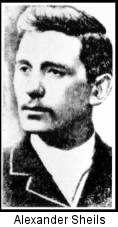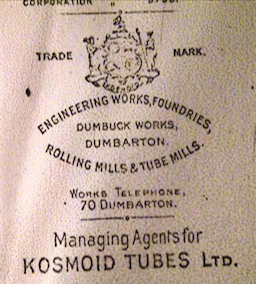Valemen and Women at Babcock and Wilcox
This entry may seem to break with our usual practice of dealing only with matters relating to the Vale and areas to the immediate north, but as the poem "Babcocks Gate" claims, Babcock & Wilcox was a wee bit of the Vale implanted into the far-flung reaches of Dumbarton. In fact, when the factory which became Babcock and Wilcox was built in 1905, it was barely part of Dumbarton, lying hundreds of yards to the south of the nearest houses with only Dumbuck House across the road to keep it company.
 It is worth very briefly relating the well-worn cautionary tale which is the early story of these works. The factory was built by a company called Kosmoid, whose leading figure was a Dr Alexander Sheils, a medical doctor whose preparation for going into industry was a spell running a successful nursing home in Glasgow. Not the best background for a captain of industry you might have thought. However, Sheils seems to have been something of a polymath and had a proven track record of profitable inventions of such things as milking machines and electrical communications on trains, as well as designing weldless tubes
It is worth very briefly relating the well-worn cautionary tale which is the early story of these works. The factory was built by a company called Kosmoid, whose leading figure was a Dr Alexander Sheils, a medical doctor whose preparation for going into industry was a spell running a successful nursing home in Glasgow. Not the best background for a captain of industry you might have thought. However, Sheils seems to have been something of a polymath and had a proven track record of profitable inventions of such things as milking machines and electrical communications on trains, as well as designing weldless tubes
So when he arrived in Dumbarton in 1905 with claims of employing 6,000 people and building a new suburb on the slopes of Dumbuck, he had credibility with the public at large and more importantly with some influential figures in the business community in the west of Scotland. The manufacture of high quality steel tubes, for which there was growing demand particularly for boilers for ships and electrical power-stations then in their infancy, boded well for the future and further enhanced the reputation of Kosmoid and Dr Sheils. If he had kept to the development of the steel tube business to the exclusion of everything else, it’s quite possible he would have ended up employing 6,000 workers. However, he apparently had other plans.
 For centuries the search for the magic formula which could turn base metals into gold had been the Holy Grail of the scientific community, as well as a sundry collection of alchemists, snake-oil salesmen, con-men and business fraudsters. However, in the 30-40 years immediately prior to Kosmoid’s formation, both physics and chemistry had seen momentous and world changing discoveries – the telephone, electricity as a usable power source, a whole range of new chemicals for industry and medicines. Why wouldn’t a process for converting base metals into gold be one of them? Rumours began to circulate in London that Sheils had discovered such a process.
For centuries the search for the magic formula which could turn base metals into gold had been the Holy Grail of the scientific community, as well as a sundry collection of alchemists, snake-oil salesmen, con-men and business fraudsters. However, in the 30-40 years immediately prior to Kosmoid’s formation, both physics and chemistry had seen momentous and world changing discoveries – the telephone, electricity as a usable power source, a whole range of new chemicals for industry and medicines. Why wouldn’t a process for converting base metals into gold be one of them? Rumours began to circulate in London that Sheils had discovered such a process.
<Read about this in a Herald Article>
At about the same time claims were being made about the origins of the name Kosmoid, suggesting that it was based on the first initial of leading figures of the day who were behind this whole enterprise. The K was supposed to represent Lord Kelvin the most eminent scientist of his day, the Os were Lord and Lady Overtoun whose fortune had been made in chemicals and who had the added benefit of living locally, as did James Denny who was supposed to be the D. There is no evidence whatsoever that any of these people were in any way involved in promoting this enterprise, although local businessmen probably did invest in it. It seems much more likely that this whole game of linking famous names from business and science with Kosmoid was the creation of people who were going to gain financially from money-raising for Kosmoid, and that takes us back to the London rumours, the City of London being a no less disreputable place a hundred years ago than it has proved to be in the past few years.
Some Dumbarton locals also tried to jump on the Kosmoid band-wagon, although for quite different reasons. The town had suffered a chronic shortage of water for many years – a shortage that was to continue into the 1960’s – and the then Provost, a Robert McFarlan, had already proposed a scheme to draw water from Loch Sloy at the heart of McFarlane clan territory. This was 25 miles away, and it would have been an enterprise beyond the financial means of anything smaller than a largish city, as was recognised only too well by many others, including councillors, who forced a public inquiry into the scheme. Kosmoid’s alleged gold manufacturing process was said to require huge amounts of water and proponents of the Loch Sloy scheme used this in support of their plans. The claims they made at the public inquiry in Glasgow into the Loch Sloy scheme only served to increase attention on Kosmoid. The public inquiry was the death-knell of the Loch Sloy scheme and it was abandoned in 1906. The interest which it had aroused led many to look more closely at Kosmoid, and doubts soon spread about its operations.
In 1907 Kosmoid closed down and Dr Sheils died and with him all attempts at gold-making in Dumbarton – if there really had been any at all. It’s probable that Sheils started out with a genuine effort to make silver and gold from base metals, and that he told his partners and investors what he was doing. There was nothing inherently wrong with that, especially against the background of advances in science at the time. The rumours, claims and fund-raising conducted by others are another matter altogether. However, the last few years have shown only too well that the financial con-man is alive, well and doing very nicely in these times as well - think toxic debt, corporate bankers, the burst Internet bubble, and we’re in no position to be smug about events of 100 years ago. Every generation produces a steady stream of successful con-men
 The Dumbarton Town Councillors emerge from this with a valid claim to having acted in the best interests of the town. True, the supporters of the Loch Sloy scheme were saved from themselves only by the public inquiry but their motivation was basically quite valid. Those who opposed it saved the town from what would almost certainly been a calamitous financial commitment.
The Dumbarton Town Councillors emerge from this with a valid claim to having acted in the best interests of the town. True, the supporters of the Loch Sloy scheme were saved from themselves only by the public inquiry but their motivation was basically quite valid. Those who opposed it saved the town from what would almost certainly been a calamitous financial commitment.
So, no precious metals were ever produced, either at Dumbarton or anywhere else in the world, and luckily for Dumbarton, Kosmoid collapsed before the Council had spent a penny on any scheme to meet the imagined water needs of Kosmoid. Equally luckily, when the collapse came in 1907, Babcock & Wilcox were on hand to step in that same year and acquire what was still a modern, profitable tube-making factory. And that’s what it stayed for B & W, virtually until the time of its closure in 1997.
The point of the poem – that you had to be a Vale man to get a job in Babcocks – was meant as a humourous swipe at the Vale men who worked there, but it did have a point. A great many Vale men did work for B&W over the years, and many of them can be seen in the images from the works. Benjy Boyle, a regular contributor to the web-site, and a former employee at Babcock, prepared a video (from which the images were sourced) and supplied the copy of the poem. We are very grateful to Benjy for this. We don’t know which Dumbartonian wrote the poem, but if any reader does know, we’ll be delighted to accredit him or her.
Click the images to open a larger version in a new window.

|

|

|

|

|

|

|

|

|

|

|

|

|

|

|

|

|

|

|

|

|

|

|

|

|

|

|

|

|

|

|

|

|

|

|
(Jim Crosthwaite who worked at the Dumbarton B&W plant has a Facebook page with some more images. If you have any images you can contact him through this page.)


